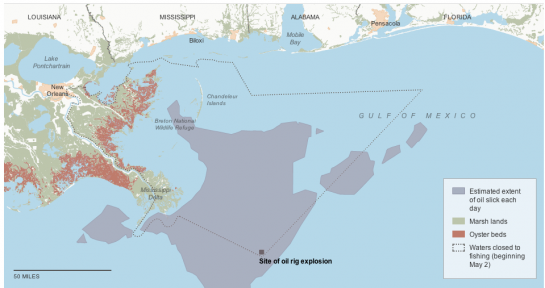Tracking the oil spill

For those following the status of the oil spill, the New York Times provides a map tracking the spread. Press play to get the day-by-day. The oil is currently spreading to the west of the Mississippi delta, getting dangerously close to the oyster beds (in red).
*****************************************
Gulf Coast oil spill concerns
Updated: Monday, 10 May 2010, 1:23 PM CDT
Published : Monday, 10 May 2010, 1:23 PM CDT
Published : Monday, 10 May 2010, 1:23 PM CDT
GULF COAST - HOW CAN THEY PLUG THE GUSHER?
Top hats and junk shots are on the list of possible next steps as BP, casting about after a 100-ton containment box failed, settles in for a long fight to stop its uncontrolled oil gusher a mile under the Gulf of Mexico.
Engineers at BP PLC were wrestling with a shopping list of ways to plug the well or siphon off the spewing crude, including a smaller containment box, dubbed a top hat, and injecting shredded rubber and other debris into the well as a stopper, called a junk shot.
SANDBAG DROP
Helicopters were dropping large sandbags in Louisiana to try to protect the Lafourche Parish marshes from the massive oil slick. The spill began creeping farther west of the Mississippi River last week.
About a dozen Louisiana National Guard soldiers affixed straps to one-ton sandbags to ready them for pickup. About 300 sandbags are expected to be used as a makeshift boom to protect the coast.
COST SO FAR
BP - which is responsible for the cleanup - said Monday the spill has cost it $350 million so far for immediate response, containment efforts, commitments to the Gulf Coast states, as well as settlements and federal costs.
The company did not speculate on the final bill, which most analysts expect to run into tens of billions of dollars.
SPILL AMOUNT
An estimated 3.9 million gallons of oil have spilled since the explosion on the Deepwater Horizon. At that pace, the spill would surpass the 11 million gallons spilled in the Exxon Valdez disaster by Father's Day.
WETLANDS
Battered by hurricanes, weakened by erosion and flood-control projects, the sprawling wetlands that nurture Gulf of Mexico marine life and buffer coastal cites from storm surges now face another stern test as a monster oil slick creeps ever closer.
About 40 percent of the nation's coastal wetlands are clumped along southern Louisiana, directly in the path of oil that was still gushing Monday from a ruptured underwater well.
Roughly 3.5 million gallons has escaped in the three weeks since an oil rig explosion, and some is bearing down on the marshes as workers rush to lay protective boom.
WATERMEN
For watermen across the Gulf Coast, waiting is now a way of life. Waiting to see where the slick will land. Waiting for crab and shrimp zones to reopen. Waiting to make some money. Many wait all day in hopes of being loaded up with boom to keep oil out of untainted waters, only to leave without work.
BP's INFLUENCE
With millions of dollars invested in campaign donations and an all-star lobbying team, BP executives could give an advanced class in how to build influence in Washington. But with millions of gallons of leaking oil bearing down on Gulf Coast beaches and bayous, they could also teach how to lose it.
Even pro-oil Republicans are demanding answers. At least for the moment, it appears that whatever clout BP has accrued, the oil company is unlikely to get delicate handling from lawmakers investigating the oil rig disaster when oversight hearings begin this week on Capitol Hill.
SHAREHOLDER SUIT
A BP shareholder has filed suit against the corporation's executives because of the offshore rig disaster that led to the oil spill in the Gulf of Mexico.
Filed in federal court in New Orleans on Friday, the lawsuit by Pennsylvania resident Katherine Firpo accuses BP PLC of ignoring safety issues on rigs such as the Deepwater Horizon.
And the suit accuses BP of pursuing cost-cutting measures at the expense of safety, while lobbying authorities to decrease safety regulation.
Copyright Associated Press,
************************************************************************
Next step to stop oil: Throw garbage at itSTORY HIGHLIGHTS
Venice, Louisiana (CNN) -- If using a massive dome to cover the source of the oil gushing into the Gulf of Mexico doesn't work, crews are preparing for another option: clogging it. Engineers are examining whether they can close a failed blowout preventer by stuffing it with trash, said Adm. Thad Allen, the commandant of the Coast Guard. The 48-foot-tall, 450-ton device sits atop the well at the heart of the Gulf oil spill and is designed to stop leaks, but it has not been working properly since the oil rig Deepwater Horizon exploded April 20 and later sank. "The next tactic is going to be something they call a junk shot," Allen told CBS's "Face the Nation" on Sunday. "They'll take a bunch of debris -- shredded up tires, golf balls and things like that -- and under very high pressure, shoot it into the preventer itself and see if they can clog it up and stop the leak." Oil company BP, the well's owner, had attempted to lower a four-story containment vessel over the well to cap the larger of the well's two leak points. But that plan was thwarted Saturday after ice-like hydrate crystals, formed when gas combined with water, blocked the top of the dome and made it buoyant. BP said it has not abandoned the dome plan. But Doug Suttles, the company's chief operating officer, told reporters that officials are considering the "junk shot" along with other possible solutions. Suttles said Saturday that trying to stuff shut the blowout preventer had not yet been attempted because of possible challenges and risks. And Allen said the approach had worked in the past, but never so deep beneath the water's surface. "We're working at 5,000 feet of depth, which has never been done before," he said. The dome was resting on the seabed Sunday while crews tried to find a way to deal with the crystals -- a process that could take two days, Suttles told reporters Saturday. Officials are considering heating the dome or adding methanol to dissolve the hydrates, he said. If the hydrate problem is resolved, BP hopes to connect the dome to a drill ship and to begin sucking oil from the containment dome. President Obama plans to meet with Cabinet members Monday afternoon to review BP's efforts to stop the oil leak and to review response efforts to the oil slick, the White House said Sunday. An estimated 210,000 gallons (5,000 barrels) of crude is pouring from the well every day. Hundreds of thousands of feet of boom and large volumes of dispersants continued to be deployed in an effort to capture or break up the spilled oil moving toward the Gulf coastline, and thousands of workers and volunteers worked to skim the water's surface. National Oceanic and Atmospheric Administration forecasters warned that the Mississippi Delta, Breton Sound, the Chandeleur Islands and areas directly north could see oil hit the coast by Tuesday, and significant winds could push oil west of the Mississippi River Delta by Monday. And scientists are analyzing tar balls found on a beach on Dauphin Island, Alabama, to determine whether they were caused by the oil spill, and Coast Guard spokesman Erik Swanson said. The tar balls are "pieces of emulsified oil" shaped like pancakes, ranging in size from dimes to golf balls, but can sometimes occur naturally, Swanson said. The U.S. Coast Guard has tallied six oiled birds that have died since the slick formed last month, Swanson said Sunday, though the cause of death is still being determined. Four additional oiled birds have been cleaned, Swanson said. A college student in Waveland, Mississippi, e-mailed CNN pictures of thousands of dead fish she found washed up on the beach near her home Saturday. Sabrina Bradford, a student at the University of Mississippi, identified the fish as menhaden, which are often used as bait or as meal to feed farm-raised fish. But William Hawkins, director of the Gulf Coast Research Laboratory at the University of Southern Mississippi, said the dead fish aren't necessarily a result of the oil slick. The fish could have died in a pocket of low-oxygen water or could have fallen out of a torn fishing net, he said. The stakes are high for residents of coastal Louisiana who make their living by fishing in the Gulf. Oil washed ashore Thursday on Louisiana's barrier islands and drifted west past the mouth of the Mississippi River. "It's killing everybody down here, everybody is more or less getting ulcers worrying about this, and it's something we experienced five years ago with [Hurricane] Katrina," charter-boat owner Tom Becker told CNN Saturday. Federal investigators are still trying determining what caused the explosion that sank the Deepwater Horizon, owned by BP contractor Transocean Ltd. The explosion left 11 men presumed dead aboard the rig and caused the massive underwater gusher that the company and the federal government have been trying to cap since late April. Suttles said Saturday that senior BP employees, including the company's vice president for drilling in the Gulf of Mexico, were on board the rig at the time of the explosion discussing its positive safety performance. "This rig had an outstanding record," he said. All six BP employees on board were among the 111 people who escaped from the burning rig, Suttles said. BP is legally required to cover economic damages from the spill up to $75 million. But Florida Sen. Bill Nelson has introduced legislation that would raise the liability cap to $10 billion. "If this gusher continues for several months, it's going to cover up the Gulf Coast and it's going to get down into the loop current and that's going to take it down the Florida Keys and up the east coast of Florida, and you are talking about massive economic loss to our tourism, our beaches, to our fisheries, very possibly disruption of our military testing and training," Nelson said Sunday on CNN's "State of the Union." ************************************************ |



